China Automotive Gesture Interaction Development Research Report,2022-2023
Vehicle gesture interaction research: in 2022, the installations rocketed by 315.6% year on year.
China Automotive Gesture Interaction Development Research Report, 2022-2023 released by ResearchInChina analyzes and studies four aspects: gesture interaction technology, benchmarking vehicle gesture interaction solutions, gesture interaction industry chain, and gesture interaction solution providers.
1. In 2022, the installations of vehicle gesture recognition functions soared by 315.6% on an annual basis.
Accompanied by iterative upgrade of intelligent cockpit technology, cockpit services are evolving from passive intelligence to active intelligence, and the human-computer interaction mode is also shifting from single-modal to multi-modal interaction. In this trend, vehicle gesture interaction functions enjoy a boom. In 2022, gesture recognition (standard configuration) was installed in 427,000 passenger cars in China, a year-on-year spurt of 315.6%, with installation rate up to 2.1%, 1.6 percentage points higher than 2021.
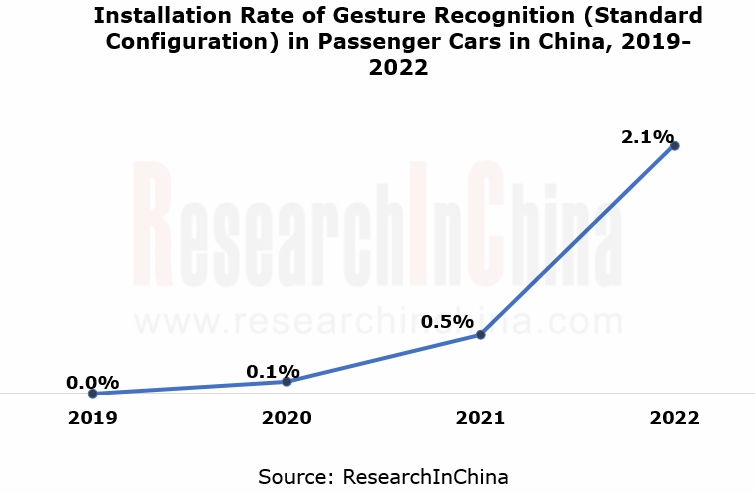
By brand, in 2022 Changan Automobile boasted the highest gesture recognition installation rate, up to 33.0%, 13.1 percentage points higher than 2021. In terms of models, in 2022, Changan Automobile had a total of 6 models (e.g., UNI-V, CS75 and UNI-K) equipped with gesture recognition as a standard configuration, 5 models more than in 2021.
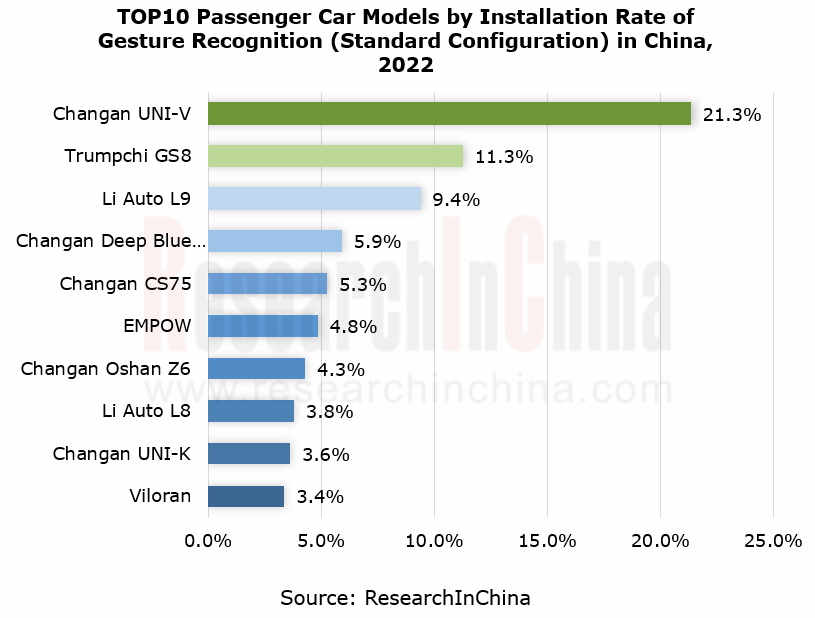
The gesture recognition feature of Changan UNI-K adopts a 3D ToF solution, enabling such functions as song switch and navigation activation. The specific gestures are: swipe the palm horizontally to left/right for playing the previous/next song; make a finger heart for navigating back home; thumb up for navigating to the workplace.
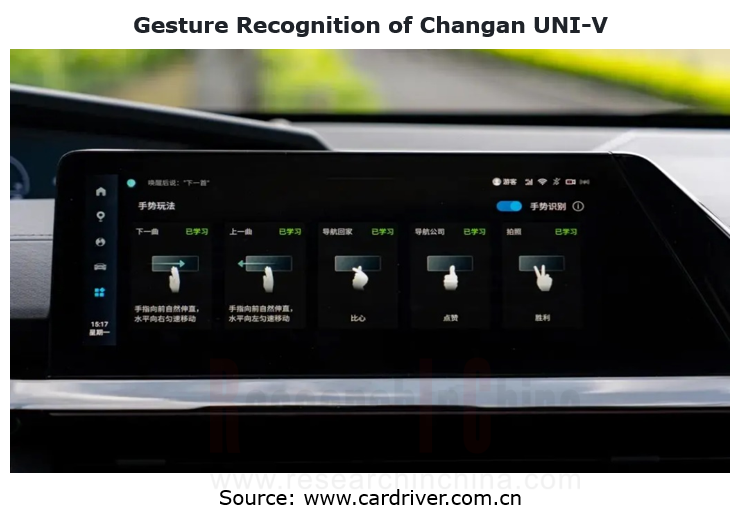
2. The control scope of gesture recognition is extending from software to hardware, and from the inside to the outside of cars.
As gesture interaction technology gains popularity and finds application in ever more scenarios, vehicle gesture interaction also springs up. At present, automakers are working hard on layout of cockpit interaction functions. Gesture controlled functions have increased from initially in-vehicle infotainment system features (e.g., phone call, media volume and navigation), to body hardware and safety systems (e.g., windows/sunroof/sunshades, doors, and driving).
In addition, manufacturers also make efforts to develop exterior gesture control technology. One example is WEY Mocha that has allowed for gesture control over ignition, forward/backward movement, stop, and flameout outside the car. In the future, gesture recognition will no longer be limited to occupants, and will gradually cover actions of passers-by outside the car, for instance, recognizing command gestures of traffic police on road or gestures made by cyclists around the car.
3. Six gesture recognition technology routes.
From the perspective of technology route, gesture recognition technologies are led by 3D camera based structured light, ToF, stereo imaging, radar-based millimeter wave, ultrasonics, and bioelectricity-based myoelectricity.
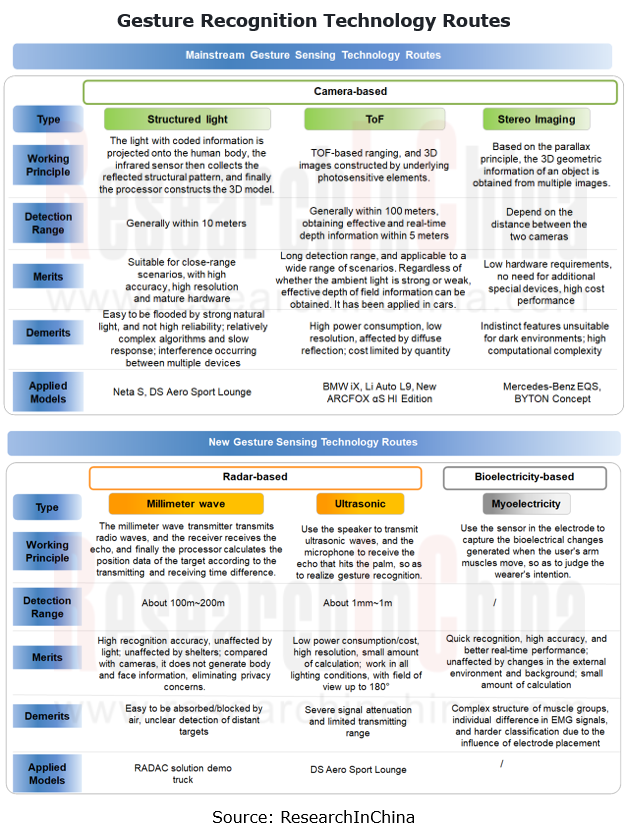
In current stage, 3D camera based gesture sensing prevails among vehicle gesture recognition technology routes. The technology route consists of 3D camera and control unit. Composed of camera, infrared LED and sensor, the 3D camera is used to capture hand movements, and then recognize the type of gestures via corresponding image processing algorithms and issue relevant instructions. The 3D camera based technology route can be subdivided into structured light, ToF and stereo vision.
1. Structured light technology refers to a solution where the light with coded information is projected onto the human body, the infrared sensor collects the reflected structural pattern, and finally the processor builds a 3D model. With benefits of mature hardware, high recognition accuracy and high resolution, it is applicable to close-range scenarios within 10 meters. The gesture recognition carried by Neta S rolled out in July 2022 is a structured light solution.
The in-cabin gesture recognition sensor of Neta S is located above the interior rearview mirror. It can recognize 6 gestures, including: swipe the palm back and forth to adjust the light transmittance of the sunroof; make the "shh" sign for the silent mode; rotate a finger clockwise/counterclockwise to adjust the volume; move the palm to left and right to switch audio and video programs; make the "V" sign to take selfies in the car; thumb up to save favorite programs.
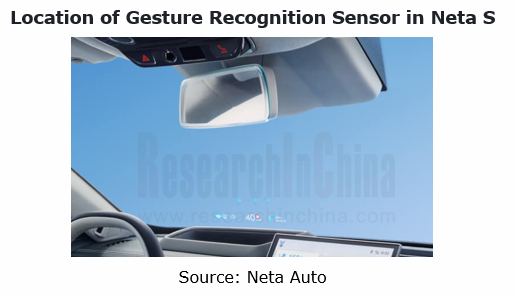
2. ToF technology, namely, time-of-flight (ToF) based ranging, is enabled with 3D images constructed by the underlying photosensitive elements. It can obtain effective and real-time depth information within 5 meters. With the applicability to a wider range of scenarios, it acquires effective depth of field information regardless of whether the ambient light is strong (e.g., sunlight) or weak. The gesture recognition solutions installed in production models like BMW iX, Li Auto L9 and new ARCFOX αS HI Edition are all ToF solutions.
The in-cabin gesture recognition sensor of BMW iX lies at the dome light above the center console screen. It can recognize 8 gestures, including:
① swipe hand to left and right to reject phone call/close the pop-up;
② point the index finger back and forth to answer phone call/confirm the pop-up;
③ rotate the index finger clockwise to turn the volume up or zoom in on the navigation map;
④ rotate the index finger counterclockwise to turn the volume down or zoom out on the navigation map;
⑤move a fist with thumb extended to left right back and forth to play the previous/next song;
⑥ point the index and middle fingers extended into the display to perform individually assignable gesture;
⑦ stretch out all five fingers, make a fist and then stretch out all five fingers again to perform individually assignable gesture;
⑧ bring thumb and index finger together and swipe the hand to the right or left for a view around the car (requiring the car to pack the automated parking assist system PLUS).

To ensure gesture recognition and control by occupants, Li Auto L9 has gesture recognition sensors installed in the fore cabin and rear cabin. The fore cabin sensor is located above the interior rearview mirror, and the rear one lies above the rear entertainment screen.
The fore cabin sensor can recognize 2 gestures, including:
①point towards windows/sunroof/sunshades to control (combined with voice interaction capability);
②make a fist and hold, and swipe up and down on the play page to adjust the volume.
The rear cabin sensor can recognize 7 gestures, including: ①stretch out all five fingers and place the inner side of elbow on the armrest for 2 seconds to activate the gesture control function; ②stretch out all five fingers and swipe the hand down to turn on the screen; ③stretch out all five fingers and swipe the hand to move the cursor; ④stretch out all five fingers and make a fist to spot the icon; ⑤stretch out all five fingers, make a fist and hold, and move the hand to share the content on the rear entertainment screen to the front display; ⑥stretch out all five fingers, make a fist and hold, and swipe the hand on the play page to left and right to adjust the play progress; ⑦stretch out all five fingers and swipe the hand up to exit the current content.
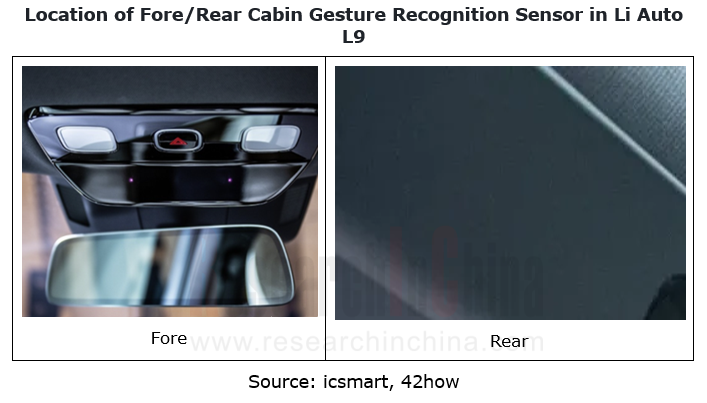
3. Stereo imaging technology based on the parallax principle is enabled with 3D geometric information of objects that is obtained from multiple images. This technology is a cost-effective solution posing low requirements for hardware and needing no additional special device. The gesture recognition solution carried by the Mercedes-Benz EQS launched in May 2022 is a stereo imaging solution.
The in-cabin gesture recognition sensor of Mercedes-Benz EQS is located at the reading light on the roof, and can recognize 3 gestures, including:
① make the "V" sign to call up favorites;
②swipe hand back and forth under the interior rearview mirror to control the sunroof;
③swipe hand toward the inside of the car to automatically close doors (requiring optional four-door electric switches).
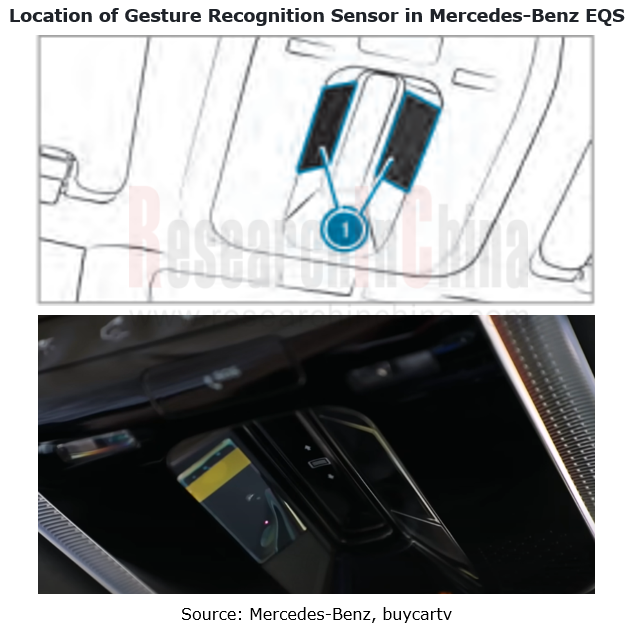
Currently gesture recognition technologies such as radar-based millimeter wave, ultrasonics, and bioelectricity-based myoelectricity have yet to be used widely in in-cabin gesture recognition functions. Compared with conventional vision-based gesture recognition, these technologies still have some limitations and pose challenges.
1. Radar is a radio wave sensor that enables accurate detection of the position and movements of hands even in the presence of obstacles.
In 2020, Ainstein, the American subsidiary of Muniu Technology, together with ADAC Automotive established a joint venture brand - RADAC. At the CES 2020, Ainstein introduced a radar–based vehicle gesture recognition solution. The gesture recognition sensor in this solution lies on the top of the tailgate, allowing users to open the door by swiping hand to left and right.
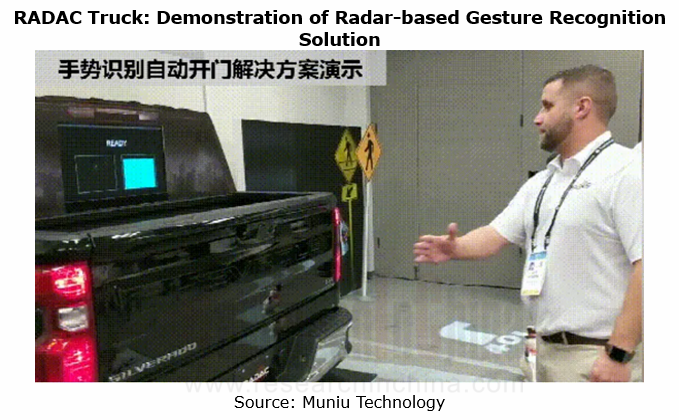
2. Ultrasonic radar. In February 2020, DS showcased the Aero Sport Lounge concept car at the Geneva International Motor Show. Integrating Leap Motion and Ultrahaptics technologies, this car can easily recognize and understand every gesture made by occupants, and give haptic feedback to them through the stereo ultrasonic waves emitted by the micro-speaker.
The in-cabin gesture recognition and ultrasonic feedback sensor of DS Aero Sport Lounge is located at the center armrest of the car, and can recognize 5 gestures, including:
①adjust in-cabin temperature and blowing velocity;
②adjust tracks and volume;
③process navigation/map, including new route settings;
④answer/reject phone calls;
⑤switch menu functions.
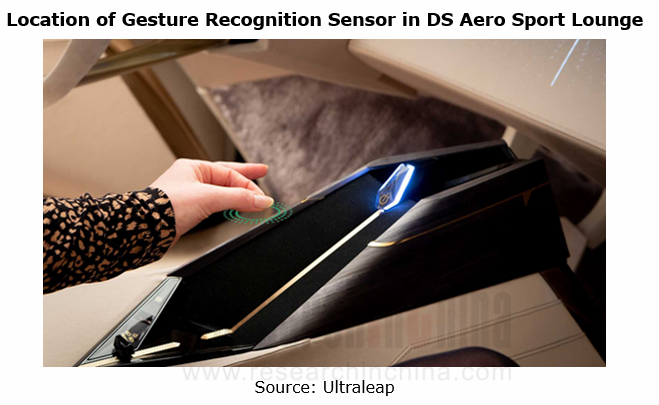
3. Bioelectricity refers to the electric signals generated by human muscular movements. Bioelectric sensors can recognize gestures and movements by measuring these signals. At present, the bioelectricity-based myoelectric gesture recognition technology is more used to control external devices and interaction interfaces, such as prosthetics, virtual reality and gaming devices. Thalmic Labs, a Canadian company dedicated to developing smart gesture control products, introduced the first wearable device, the MYO armband, which uses myoelectricity technology. The eight myoelectric sensors embedded in the armband record the electric signals of arm muscles, and recognize different gestures by analyzing these signals. In the actual application, users can control drones, computers, smartphones and other electronic devices through the Bluetooth connect of MYO. There are no vehicle use cases at present.
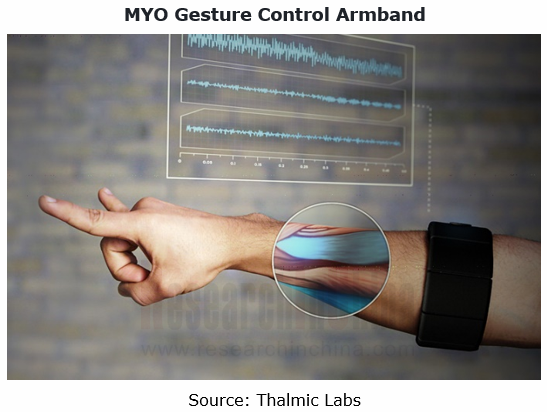
China Automotive Lighting and Ambient Lighting System Research Report, 2025
Automotive Lighting System Research: In 2025H1, Autonomous Driving System (ADS) Marker Lamps Saw an 11-Fold Year-on-Year Growth and the Installation Rate of Automotive LED Lighting Approached 90...
Ecological Domain and Automotive Hardware Expansion Research Report, 2025
ResearchInChina has released the Ecological Domain and Automotive Hardware Expansion Research Report, 2025, which delves into the application of various automotive extended hardware, supplier ecologic...
Automotive Seating Innovation Technology Trend Research Report, 2025
Automotive Seating Research: With Popularization of Comfort Functions, How to Properly "Stack Functions" for Seating?
This report studies the status quo of seating technologies and functions in aspe...
Research Report on Chinese Suppliers’ Overseas Layout of Intelligent Driving, 2025
Research on Overseas Layout of Intelligent Driving: There Are Multiple Challenges in Overseas Layout, and Light-Asset Cooperation with Foreign Suppliers Emerges as the Optimal Solution at Present
20...
High-Voltage Power Supply in New Energy Vehicle (BMS, BDU, Relay, Integrated Battery Box) Research Report, 2025
The high-voltage power supply system is a core component of new energy vehicles. The battery pack serves as the central energy source, with the capacity of power battery affecting the vehicle's range,...
Automotive Radio Frequency System-on-Chip (RF SoC) and Module Research Report, 2025
Automotive RF SoC Research: The Pace of Introducing "Nerve Endings" such as UWB, NTN Satellite Communication, NearLink, and WIFI into Intelligent Vehicles Quickens
RF SoC (Radio Frequency Syst...
Automotive Power Management ICs and Signal Chain Chips Industry Research Report, 2025
Analog chips are used to process continuous analog signals from the natural world, such as light, sound, electricity/magnetism, position/speed/acceleration, and temperature. They are mainly composed o...
Global and China Electronic Rearview Mirror Industry Report, 2025
Based on the installation location, electronic rearview mirrors can be divided into electronic interior rearview mirrors (i.e., streaming media rearview mirrors) and electronic exterior rearview mirro...
Intelligent Cockpit Tier 1 Supplier Research Report, 2025 (Chinese Companies)
Intelligent Cockpit Tier1 Suppliers Research: Emerging AI Cockpit Products Fuel Layout of Full-Scenario Cockpit Ecosystem
This report mainly analyzes the current layout, innovative products, and deve...
Next-generation Central and Zonal Communication Network Topology and Chip Industry Research Report, 2025
The automotive E/E architecture is evolving towards a "central computing + zonal control" architecture, where the central computing platform is responsible for high-computing-power tasks, and zonal co...
Vehicle-road-cloud Integration and C-V2X Industry Research Report, 2025
Vehicle-side C-V2X Application Scenarios: Transition from R16 to R17, Providing a Communication Base for High-level Autonomous Driving, with the C-V2X On-board Explosion Period Approaching
In 2024, t...
Intelligent Cockpit Patent Analysis Report, 2025
Patent Trend: Three Major Directions of Intelligent Cockpits in 2025
This report explores the development trends of cutting-edge intelligent cockpits from the perspective of patents. The research sco...
Smart Car Information Security (Cybersecurity and Data Security) Research Report, 2025
Research on Automotive Information Security: AI Fusion Intelligent Protection and Ecological Collaboration Ensure Cybersecurity and Data Security
At present, what are the security risks faced by inte...
New Energy Vehicle 800-1000V High-Voltage Architecture and Supply Chain Research Report, 2025
Research on 800-1000V Architecture: to be installed in over 7 million vehicles in 2030, marking the arrival of the era of full-domain high voltage and megawatt supercharging.
In 2025, the 800-1000V h...
Foreign Tier 1 ADAS Suppliers Industry Research Report 2025
Research on Overseas Tier 1 ADAS Suppliers: Three Paths for Foreign Enterprises to Transfer to NOA
Foreign Tier 1 ADAS suppliers are obviously lagging behind in the field of NOA.
In 2024, Aptiv (2.6...
VLA Large Model Applications in Automotive and Robotics Research Report, 2025
ResearchInChina releases "VLA Large Model Applications in Automotive and Robotics Research Report, 2025": The report summarizes and analyzes the technical origin, development stages, application cases...
OEMs’ Next-generation In-vehicle Infotainment (IVI) System Trends Report, 2025
ResearchInChina releases the "OEMs’ Next-generation In-vehicle Infotainment (IVI) System Trends Report, 2025", which sorts out iterative development context of mainstream automakers in terms of infota...
Autonomous Driving SoC Research Report, 2025
High-level intelligent driving penetration continues to increase, with large-scale upgrading of intelligent driving SoC in 2025
In 2024, the total sales volume of domestic passenger cars in China was...